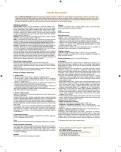-
Medical journals
- Career
Urinary incontinence induced by the antidepressants – case report
Authors: J. Krhut 1,2; M. Gärtner 3
Authors‘ workplace: Urologické oddělení FN, Ostrava, primář doc. MUDr. J. Krhut, Ph. D. 1; Katedra chirurgických oborů LF OU, Ostrava, přednosta doc. MUDr. P. Zonča, Ph. D., FRCS 2; Gynekologicko-porodnická klinika FN, Ostrava, přednosta doc. MUDr. V. Unzeitig, CSc. 3
Published in: Ceska Gynekol 2015; 80(1): 65-68
Overview
Aim:
Case study of the patient with urinary incontinence induced by the antidepressant mirtazapin and the review of the related literature.Design:
Case report.Setting:
Department of Urology, University Hospital Ostrava-Poruba.Case report:
A case of 55-years old patiens, who was reffered to the surgical treatment of the urinary incontinence. We found a major discrepancies during the evaluation that led us to suspect that this is not a common uncomplicated case of stress urinary incontinence. Based on the detailed history we identified the antidepressant mirtazapine as a likely causal factor. After discontinuing mirtazapin patient has achieved full control of the continence.Conclusion:
Given that antidepressants affects adrenergic and dopaminergic regulatory mechanisms in the central nervous system, they may affect the lower urinary tract function. This work presents a case report where the disclosure of the less common cause of incontinence saved the patientoriginally proposed surgical treatment and allowed the effective restoration of the continence. We emphasize the need to consider the potential interaction of antidepressants with lower urinary tract function in daily practice.Keywords:
urinary incontinence, antidepressants, serotonin, noradrenalin, mirtazapine
Sources
1. Abrams, P., Cardozo, L., Fall, M., et al. Standardisation sub-committee of the International Continence Society: The standardisation of terminology in lower urinary tract function: report from the standardisation sub-committee of the International Continence Society. Urology, 2003, 61, 1, p. 37–49.
2. Blackett, H., Walker, R., Wood, B. Urinary dysfunction in Parkinson´s disease: a review. Parkinsonism Relat Disord, 2009, 15, 2, p. 81–87.
3. Drake, MJ., Nixon, PM., Crew, JP. Drug-induced bladder and urinary disorders. Drug Safety, 1998, 19, 1, p. 45–55.
4. Hall, SA., Maserejian, NN., Link, CL., et al. Are commonly used psychoactive medications associated with lower urinary tract symptoms? Eur J Clin Pharmacol, 2012, 68, 5, p. 783–791.
5. Hannestad, YS., Rortveit, G., Sandvik, H., Hunskaar, S. A community-based epidemiological survey of female urinary incontinence: the Norwegian EPINCONT study. Epidemiology of Incontinence in the County of Nord-Trondelag. J Clin Epidemiol, 2000, 53, 11, p. 1150–1157.
6. Kent, JM. SNaRIs, NaSSAs, and NaRIs: new agents for the treatment of depression. Lancet, 2000, 355, p. 911–918.
7. Kessler, RC., Berglund, P., Demler, O. The epidemiology of major depressive disorder: Results from the National Comorbidity Survey Replication (NCS-R). JAMA, 2003, 289, 203, p. 3095–3105.
8. Mariappan, P., Alhasso, A., Ballantyne, Z., et al. Duloxetine, a serotonin and noradrenaline reuptake inhibitor (SNRI) for the treatment of stress urinary incontinence: a systematic review. Eur Urol, 2007, 51, 1, p. 67–74.
9. Milsom, I., Kaplan, SA., Coyne, KS., et al. Effect of bothersome overactive bladder symptoms on health-related quality of life, anxiety, depression, and treatment seeking in the United States: results from EpiLUTS. Urology, 2012, 80, 1, p. 90–96.
10. Movig, KLL., Leufkens, HGM., Belitser, SV., et al. Selective serotonin reuptake inhibitor-induced urinary incontinence. Pharmacoepidemiol Drug Saf, 2002, 11, 4, p. 271–279.
11. Seventh report on the standardisation of terminology of lower urinary tract function: lower urinary tract rehabilitation techniques. International Continence Society Committee on Standardisation of Terminology. Scand J Urol Nephrol, 1992, 26, p. 99.
Labels
Paediatric gynaecology Gynaecology and obstetrics Reproduction medicine
Article was published inCzech Gynaecology

2015 Issue 1-
All articles in this issue
- HPV in etiology of orofaryngeal cancer according to sexual activity
- Vacuum-assisted vaginal delivery does not significantly contribute to the higher incidence of levator ani avulsion
- Basal cell carcinoma in a young patient
- Anterior colporrhaphy under local anesthesia
- The 2-dose schedule of HPV vaccines in young adolescents
- Fetal magnetocardiography: A promising way to diagnose fetal arrhytmia and to study fetal heart rate variability?
- Urinary incontinence induced by the antidepressants – case report
- Peripartal hemorrhage with a necessity to make a hysterectomy as a life-rescuing operation – case report
- Placenta accreta – case report
- Recurrent implantation failure and thrombophilia
- The risk factors for pelvic floor trauma following vaginal delivery
- Hyperechogenic fetal bowel as a markerof fetal cystic fibrosis
- Transurethral Injection of Polyacrylamide Hydrogel (Bulkamid®) for the Treatment of Recurrent Stress Urinary Incontinence after Failed Tape Surgery
- Eclampsia as a cause of secondary non-obstructive central sleep hypoventilation
- The 4G/4G polymorphism of the plasminogen activator inhibitor-1 (PAI-1) gene as an independent risk factor for placental insufficiency, which triggers fetal hemodynamic centralization
- Czech Gynaecology
- Journal archive
- Current issue
- Online only
- About the journal
Most read in this issue- The 4G/4G polymorphism of the plasminogen activator inhibitor-1 (PAI-1) gene as an independent risk factor for placental insufficiency, which triggers fetal hemodynamic centralization
- The risk factors for pelvic floor trauma following vaginal delivery
- Anterior colporrhaphy under local anesthesia
- Transurethral Injection of Polyacrylamide Hydrogel (Bulkamid®) for the Treatment of Recurrent Stress Urinary Incontinence after Failed Tape Surgery
Login#ADS_BOTTOM_SCRIPTS#Forgotten passwordEnter the email address that you registered with. We will send you instructions on how to set a new password.
- Career

